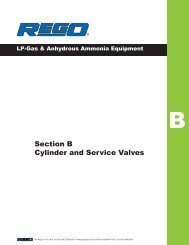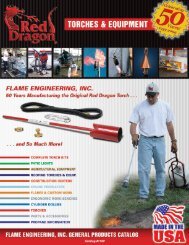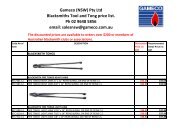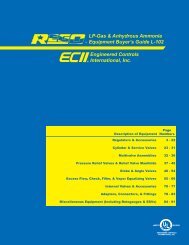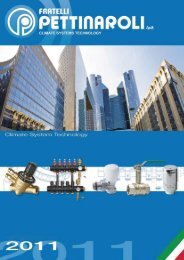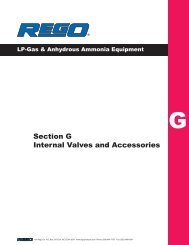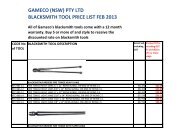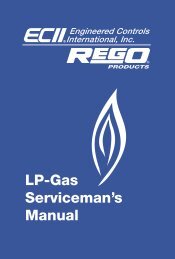Repair Kits Available By Part Number Section 2 Page - GAMECO
Repair Kits Available By Part Number Section 2 Page - GAMECO
Repair Kits Available By Part Number Section 2 Page - GAMECO
You also want an ePaper? Increase the reach of your titles
YUMPU automatically turns print PDFs into web optimized ePapers that Google loves.
WARNING: Installation, disassembly, repair and maintenance must<br />
be performed only by qualified personnel.<br />
All gas MUST be evacuated from the system before starting<br />
repairs. Remove the entire valve before performing repairs.<br />
Emergency service, on the actuator and lower stem assembly<br />
portion of the valve only, may be carried out with the valve installed,<br />
provided downstream pressure is relieved under the same conditions<br />
required for releasing LP-Gas, as in the caution below, and<br />
that there is positive assurance that the valve is closed tight with<br />
no leakage past the seats.<br />
Installation, usage and maintenance of this product must be in<br />
compliance with all Engineered Controls International, Inc. instructions<br />
as well as requirements and provisions of NFPA #54, NFPA<br />
#58, DOT, ANSI, all applicable federal, state, provincial and local<br />
standards, codes, regulations and laws.<br />
Inspection and maintenance on a periodic basis is essential.<br />
Be sure all instructions are read and understood before installation,<br />
operation and maintenance. These instructions must be<br />
passed along to the end user of the product.<br />
CAUTION: Contact or inhalation of liquid propane, ammonia and<br />
their vapors can cause serious injury or death! NH3 and LP-Gas<br />
must be released outdoors in air currents that will insure dispersion<br />
to prevent exposure to people and livestock. LP-Gas must be kept<br />
far enough from any open flame or other source of ignition to<br />
prevent fire or explosion! LP-Gas is heavier than air and may not<br />
disperse or evaporate rapidly if released in still air.<br />
Disassembly and <strong>Repair</strong> Procedure<br />
CAUTION: READ THROUGH ALL OF THESE INSTRUCTIONS, IN-<br />
CLUDING THE NOTICE AND WARNINGS BEFORE BEGINNING ANY<br />
DISASSEMBLY OR REPAIR.<br />
NOTE: Before repairing valve, thoroughly examine valve lever and all<br />
associated parts for excessive wear. Check handle for proper function<br />
and flange seating surfaces for excessive wear and damage. Any<br />
components that are not in good condition and not fully operational<br />
should be replaced during repairs.<br />
<strong>Repair</strong>s must be performed in a clean area. Hands, clothing, tools and<br />
work area must be completely free of oil, grease, and foreign matter to<br />
prevent contamination of component parts and valves.<br />
Manual / Pneumatic Actuator Disassembly<br />
NOTE: The standard A3217F Series is equipped with a manual<br />
actuator. It is possible that the valve under repair has been fitted with<br />
a A3217FPA pneumatic actuator. Please follow the disassembly and<br />
reassembly procedures for the appropriate actuator.<br />
Manual Actuator Removal<br />
1. Remove the cotter pin from the handle/stem assembly that is<br />
located in the outer most area of the stem. Discard cotter pin.<br />
2. Loosen and remove steel bolt from the stem. Save bolt and washer<br />
for reassembly.<br />
3. Remove handle from stem. Save handle for reassembly.<br />
Pneumatic Actuator Removal<br />
1. Remove cotter pin from pivot pin, located behind the clevis, and<br />
discard. Remove the pivot pin and washers. Save parts for<br />
reassembly.<br />
2. To remove crank arm, first remove cotter pin from crank arm and<br />
discard. Rotate the crank arm counterclockwise until the leg clears<br />
the clevis. Pull the crank arm off the stem. Remove nylon washer.<br />
Retain all parts.<br />
3. Remove and retain bracket screws and bracket lock washers. The<br />
actuator bracket can now be removed and saved.<br />
Valve Disassembly<br />
Stem Assembly<br />
1. Remove retaining ring and cam located on the stem inside the valve<br />
outlet port. Discard retaining ring and save the cam for reassembly.<br />
2. Remove the roll pin and cam driver from stem. Discard the roll pin<br />
and save the cam driver for reassembly.<br />
3. Using a 1 3 /8" wrench, completely loosen and remove the seal gland.<br />
A3217F-80 <strong>Repair</strong> Kit for<br />
A3217F Series 3" Internal Valves<br />
with O-Ring Flange Seals<br />
Remove the entire seal gland and stem assembly from the valve.<br />
4. Carefully remove the seal gland from the stem so as not to damage<br />
any of the parts, especially the stem.<br />
5. Remove the stem spring, stem washer, jam ring, and three (3) stem<br />
seals from the seal gland. Discard all parts except the seal gland,<br />
stem washer and stem seal spring.<br />
6. Remove the outer stem bearing and stem o-ring from the seal gland<br />
and discard. Remove and discard the dust seal which is press fitted<br />
into the seal housing. Retain the seal gland and stem.<br />
7. Remove the inner stem bearing from the valve body and discard.<br />
8. Check the stem seal gland and stem for excessive wear and/ or<br />
damage, especially in the sealing areas. If necessary replace the<br />
stem with part number A3217-39 and seal gland with part number<br />
A3217-43.<br />
Bonnet Assembly<br />
1. Remove the strainer screws, strainer top, strainer washer and<br />
strainer from the valve. Save these parts.<br />
2. Remove the four (4) bonnet screws, one at a time, being sure that<br />
the last two screws are removed directly opposite of each other.<br />
When removing the last two (2) screws hold down on the bonnet<br />
as it is spring loaded. Remove the bonnet and return spring. Save<br />
these parts.<br />
3. Using an appropriate retaining ring pliers, carefully remove the<br />
retaining ring from the disc holder, as it is spring loaded. Remove<br />
the spring retainer, excess flow spring, poppet washer and poppet<br />
from inside of the disc holder. Save these parts.<br />
4. Remove the four (4) disc holder screws from the disc holder.<br />
Remove and retain for reassembly. Remove the main seat disc, pilot<br />
seat disc and seat retainer. Be careful not to damage the inside<br />
diameter bore of disc retainer. Discard the main seat disc and pilot<br />
seat disc. Save all other parts.<br />
5. Remove seat ring, seat o-ring and poppet seal o-ring from the<br />
valve body. Retain the seat ring, discard seat o-ring and poppet<br />
seal o-ring.<br />
6. Remove roll pin and wear button from poppet, retain poppet and<br />
discard wear button and roll pin.<br />
7. Remove and discard the upper flange seal o-ring and lower flange<br />
seal o-ring from the valve body.<br />
8. Check the stem, seat retainer and seat ring for excessive wear and/<br />
or damage. Replace if necessary with part number A3217-7 for the<br />
poppet, A3217-4 for the seat retainer, and A3217-37 for the seat<br />
ring.<br />
Valve Reassembly<br />
NOTE: Clean all parts prior to reassembly. When lubrication is required<br />
use compound 11550-215 found in the enclosed kit, number 5555GP<br />
(hydrolith grease). Apply all lubricant as a thin film.<br />
Seal Gland/Stem Subassembly<br />
1. Lubricate new outer stem bearing and new stem o-ring and<br />
assemble into seal gland.<br />
2. Lubricate new dust seal and press fit in place into seal gland.<br />
3. Lubricate stem and carefully insert it, tapped end out, through the<br />
seal gland assembly. Do not use excessive force which would cut<br />
the o-ring or dust seal.<br />
4. Lubricate the three (3) new stem seal rings, new jam ring and stem<br />
washer. Assemble these one piece at a time over the stem and into<br />
the seal gland. Be careful not to damage any pieces on the flat<br />
edges of the stem.<br />
5. Set assembly aside.



